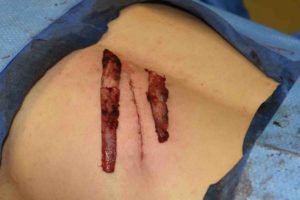Rib removal for aesthetic purposes is most commonly done for waistline reduction or narrowing. It is most commonly done in thinner women who desire the maximal waistline reduction beyond what weight loss and exercise can achieve. It is also done in transgender females who strive to have more of an hourglass shape but have a genetically wider ribcage.
Rib removal in waistline reduction focuses on ribs #s 11 and 12 which have a more vertical orientation than all the ribs above them which wrap around more horizontally. The downward angulation of the true free floating ribs can pose the last barrier to structural waistline support for maximal inward narrowing.
But rib removal can also be done for other more medical reasons as well. Known as impingement, ribs that have been fractured or displaced can cause pain by putting pressure on adjacent structures. The level of the rib involvement would determine the type and location of this type of compressive discomfort.

Dr. Barry Eppley
Indianapolis, Indiana


